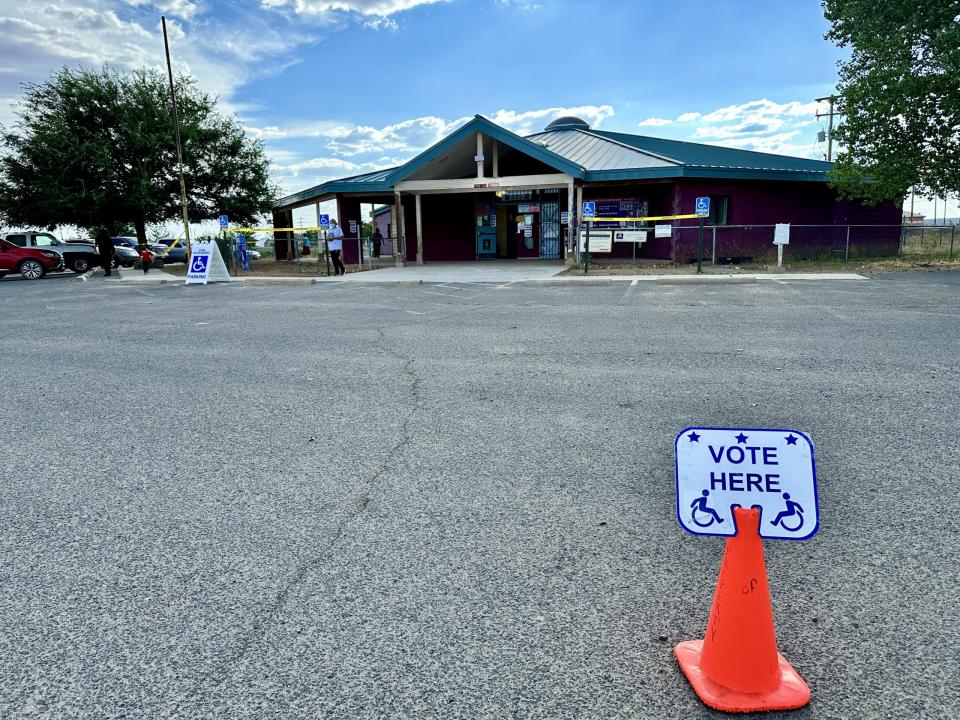My firsthand experience with the unique barriers to voting that face Indigenous Arizonans

A sign directing voters to a polling location on the Navajo Nation on July 30, 2024. (Photo by Shondiin Silversmith / Arizona Mirror)
Covering elections as a journalist on the Navajo Nation can be challenging due to the sheer size of their tribal land in Arizona. But what often gets lost is that Indigenous voters face those same challenges — not to do their job, but to participate in their own governance and have their voice heard.
The Arizona primary election was on Tuesday, and as part of my job, I visited different polling locations to see if any voters wanted to chat about the election. Spoiler: No one wanted to, at least on the record.
I have always covered state elections from the Navajo Nation in northern Arizona, and was struck this year by just how difficult it was — and how different it is from driving to multiple polling locations in Maricopa County.
On Tuesday, I spent the day driving around the Navajo Nation and some parts of the Hopi Nation, stopping off at polling locations in Navajo and Apache counties. By the end of the day, I had spent nearly 10 hours in my car, driving more than 250 miles, and visited only 10 polling locations. If I were in Maricopa County, I would’ve hit 10 polling locations within a few hours and far fewer miles.
There were over 230 polling places in Maricopa County Apache County had only 44, while Navajo County had just 39.
The Navajo Nation’s land mass on the Arizona side spreads across Apache and Navajo counties and partially into Coconino County. The Hopi Nation spreads into part of Coconino County and across Navajo County.
I have voted at my local chapter house in my community for a few election cycles now, and often voting includes casting a ballot for tribal, state, and federal elections.
It really should not surprise me how rural and spread out the polling locations are in this part of Arizona, or that voter turnout during a primary election is dismal. But it still does.
My family lives about 12 miles from our Apache County polling location, and it takes at least 20 minutes to get to the polls. The whole trip, including casting our ballots, can take about an hour.
On average, the polling stations within the Navajo Nation are about 20 to 30 miles apart, depending on the part of the reservation you live in. But there are places where people may have to drive up to an hour — one way — just to vote.
As I visited voting sites throughout the day, I noticed a few things at each of them. Turnout was small: I never got to a site and saw lines outside. At most, there were a handful of voters coming and going at any time.
One election official at the Kin Dah Lichii Chapter House told me that it was still early, and many voters work for the tribe and won’t be let out until after 3 p.m. to go vote. Polling locations in Arizona are open from 6 a.m. to 7 p.m.
Voter turnout may increase later in the day at polling locations in more populated areas of the Navajo Nation, such as Window Rock or Chinle, though late-day surges of voters often don’t materialize in the smaller polling locations in the more rural parts of the reservation.
Another thing to note is that the atmosphere at some voting locations is energetic, while others are simply places to vote with no real interactions with others.
My dad used to tell me how he would vote about an hour or two before the polls closed because he liked socializing afterward. He’d sit at tables set up by local advocates, enjoy a bowl of stew, and talk local politics with people from his community.
That atmosphere can still be seen at polling places across the Navajo Nation. At the Fort Defiance Chapter House, an entire area is blocked off for voting advocates to set up in a dirt parking area nearby.
When I stopped by around noon, there were very few voters walking in and out of the chapter house, but several canopies were set up where local advocates handed out soda, water and food after voters finished.
One thing to note about the supporters who set up on Election Day is that they are mostly for tribal candidates, and very few are for state or federal candidates.
Driving from voting site to voting site, I probably saw only a handful of campaign signs for state and federal candidates. The many signs that covered the fences entering the chapter houses or lined populated driving areas were predominantly tribal candidates for local seats, such as the chapter president or school board.
As you travel west on State Route 264 through Navajo County, you drive through part of the Hopi Nation. I am familiar with the area and have visited the polling location on the Hopi Nation before, but I learned that many people have no idea it’s even there.
During a pit stop in Keams Canyon, which is about 20 miles away from a Navajo County polling location on the Hopi Nation, I wanted to make sure that there were no polling locations in Keams Canyon itself, because it’s a small community.
I asked the gas station and marketplace clerks if they knew where the polling site site was and if they would vote in the Arizona primary election.
None of them knew it was Election Day or where they could go to vote. The gas station clerk told me I had a good chance of finding out that information from the nearby hospital.
A similar interaction occurred after visiting another Navajo County polling location at the Hardrock Chapter House.
I noticed an older Navajo man riding his horse away from the chapter house, and I was curious if he had finished voting and was maybe headed home.
I pulled up beside him in my car and asked if he voted. He told me that he did not know it was Election Day, but he’d be sure to visit the chapter house before polls closed to vote.
There are many communities in Arizona where it’s hard to get people to vote and there are pointed efforts to encourage voter turnout. However, not all communities in Arizona have been denied their right to vote for over a century.
Indigenous people were not considered citizens of the United States until 1924 —12 years after Arizona became a state and about 60 years after it became a U.S. territory — and it would take decades for many to gain access to the rights that are supposed to coincide with citizenship, including voting.
Indigenous people in Arizona were not granted the right to vote until 1948.
Arizona has one of the largest Native voting populations in the country, with more than 305,000 people of voting age, according to the National Congress of American Indians. Indigenous people make up 6% of Arizona’s overall population.
In 2020, I worked for the Arizona Republic and wrote a piece highlighting how Indigenous communities contributed to turning Arizona blue during Joe Biden’s historic win in what had long been a reliably red state.
The story came from when I tweeted an observation about the voting maps: how many of the voting precincts that turned blue fell within the boundaries of tribal nations across Arizona.
In the 2020 general election, Native voters cast more than 69,000 votes in six counties with large Indigenous populations, and of those, about 52,000, or 75%, were cast for Biden. His margin in Arizona was just over 10,000 votes.
About an hour before the polls closed on Tuesday, a voter advocate set up at Pinon Chapter House told me that she saw roughly 400 voters come throughout the day and that advocates are going to have to strategize more to get more voters during the general election.
Statewide, voter turnout was a little over 26%, according to the unofficial election results from the Secretary of State.
We’re in the last leg of the 2024 election cycle, which includes a presidential election in November. Candidates should pay more attention to Indigenous communities, especially in Arizona, where its status as a battleground state means races are likely to be decided by narrow margins.
After covering another Election Day on the Navajo Nation, I want to note that voter education is drastically needed within the community, and the main people providing that education are the Native voting advocates who are on the ground talking directly to their communities. One thing I’ve never seen are state or federal campaign managers or advocates for candidates who are working to engage Native voters while I am out covering Election Day.
Voting within Indigenous communities is a grassroots movement led by people from their communities who care and want to ensure that their community members understand what is on the ballot this election season.
Arizona Mirror is part of States Newsroom, a nonprofit news network supported by grants and a coalition of donors as a 501c(3) public charity. Arizona Mirror maintains editorial independence. Contact Editor Jim Small for questions: info@azmirror.com. Follow Arizona Mirror on Facebook and X.


